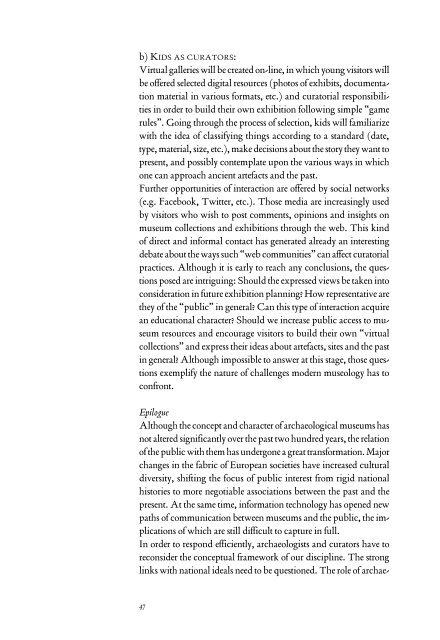Download ebook FREE - Allemandi
Download ebook FREE - Allemandi
Download ebook FREE - Allemandi
Create successful ePaper yourself
Turn your PDF publications into a flip-book with our unique Google optimized e-Paper software.
) kids as cUrators:<br />
Virtual galleries will be created on-line, in which young visitors will<br />
be offered selected digital resources (photos of exhibits, documentation<br />
material in various formats, etc.) and curatorial responsibilities<br />
in order to build their own exhibition following simple “game<br />
rules”. Going through the process of selection, kids will familiarize<br />
with the idea of classifying things according to a standard (date,<br />
type, material, size, etc.), make decisions about the story they want to<br />
present, and possibly contemplate upon the various ways in which<br />
one can approach ancient artefacts and the past.<br />
Further opportunities of interaction are offered by social networks<br />
(e.g. Fac<strong>ebook</strong>, Twitter, etc.). Those media are increasingly used<br />
by visitors who wish to post comments, opinions and insights on<br />
museum collections and exhibitions through the web. This kind<br />
of direct and informal contact has generated already an interesting<br />
debate about the ways such “web communities” can affect curatorial<br />
practices. Although it is early to reach any conclusions, the questions<br />
posed are intriguing: Should the expressed views be taken into<br />
consideration in future exhibition planning? How representative are<br />
they of the “public” in general? Can this type of interaction acquire<br />
an educational character? Should we increase public access to museum<br />
resources and encourage visitors to build their own “virtual<br />
collections” and express their ideas about artefacts, sites and the past<br />
in general? Although impossible to answer at this stage, those questions<br />
exemplify the nature of challenges modern museology has to<br />
confront.<br />
Epilogue<br />
Although the concept and character of archaeological museums has<br />
not altered significantly over the past two hundred years, the relation<br />
of the public with them has undergone a great transformation. Major<br />
changes in the fabric of European societies have increased cultural<br />
diversity, shifting the focus of public interest from rigid national<br />
histories to more negotiable associations between the past and the<br />
present. At the same time, information technology has opened new<br />
paths of communication between museums and the public, the implications<br />
of which are still difficult to capture in full.<br />
In order to respond efficiently, archaeologists and curators have to<br />
reconsider the conceptual framework of our discipline. The strong<br />
links with national ideals need to be questioned. The role of archae-<br />
47







